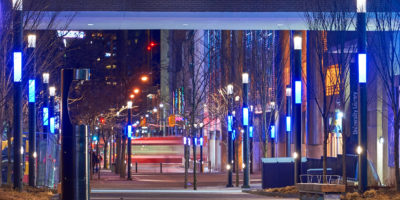By Abby Hughes
While Ryerson may no longer be a complete ghost town with a hybrid fall semester underway, many students say campus still looks barren.
Ryerson president Mohamed Lachemi announced on June 8 that some in-person classes and activities would resume during the fall 2021 term. Lachemi called this semester a “transition period” in preparation for a full return to campus by winter 2022.
In addition, the Sheldon & Tracy Levy Student Learning Centre (SLC), Mattamy Athletic Centre, Recreation and Athletic Centre, the university library and other services are also open to students with enhanced COVID-19 safety protocols.
Second-year creative industries student Jaedyn Townsley said when she heard the June announcement, it sounded like a fair compromise.
“I really want it to be a safe year too, so [a hybrid model] is a better option for now rather than fully going back to in-person courses,” said Townsley.
Expecting about a third of her courses to be in-person, Townsley moved from Niagara to Toronto to be closer to campus. She had already signed her lease when she found out she had no in-person courses in the fall term, she said.
“The profs are doing the best they can and the lectures are good,” said Townsley, despite feeling “somewhat ripped off.”
“Tuition prices don’t really reflect the amount we’re getting out of it,” she added.
“I really want it to be a safe year too, so a hybrid model is a better option for now rather than fully going back to in-person courses”
For that reason, radio and television arts (RTA) associate professor Marion Coomey said she’s glad to be on campus to teach studio-intensive classes this fall.
“I’m really happy I get to work with students in the studio setting where they want to be,” Coomey said. “It’s much more creative for them and better for me to teach them in the studio setting.”
Coomey said the university’s COVID-19 protocols have been very clear so far, making the classroom feel safe.
“I walked into the studio and, in many ways, it felt like I was there yesterday,” Coomey said of her first day back on campus. Aside from COVID-19 protocol posters, masking, fewer students in class at a time and contact tracing, she said it “felt like a regular class.”
At the RTA School of Media, Coomey said faculty members were asked what classes they hoped to teach in a hybrid model and to provide their reasoning and logistics of hybrid delivery for those courses.
Requests for hybrid courses were either approved or denied by program administrators.
Coomey said one of her students commutes an hour to school for her 9 a.m. hybrid class on Mondays. That student, and all but one student in Coomey’s Monday class, said they still wanted to attend the class in person for sessions that were less hands-on.
Coomey added that the social aspect of in-person learning is a driving force for students.
“I feel like I’m so disconnected from the school. It’s been so hard to make friends and get involved”
Bianca Perry, a second-year psychology student, said she feels like she’s missed out on the social environment of student life. Like Townsley, all of her courses are online this term.
“I feel like I’m so disconnected from the school. It’s been so hard to make friends and get involved,” said Perry.
She added that once students get in a pattern of staying at home for class, it’s tough to break the habit and venture out to meet new people.
Perry said she’s glad the school has made services like the SLC open to students, which help combat the disconnect she feels. She plans to attend one class per week from the SLC to create a sense of normalcy within her education.
As well as students, faculty members are also reliving the challenges that come with online course delivery.
Mahdi Roghanizad, an assistant professor in Ryerson’s human resource management and organizational behaviour department, researches the social psychology of virtual communication.
In a study conducted by Roghanizad and professors Roderick White and Derrick Neufeld at Western University’s Ivey Business School, participants tried to predict how cooperative a stranger was when interacting both in-person and via video call.
The study found that those communicating by video were less accurate in predicting the behaviour of the other person than those who communicated face-to-face.
Backed up by research in the field of evolutionary psychology, Roghanizad said his research shows our brains are “hardwired for face-to-face interaction.”
“The underlying personal, friendly relationship I can build with my students face-to-face, it’s almost impossible to make in Zoom classes”
While his research was on predicting the cooperativeness of a stranger rather than online learning, he sees similar difficulties in his classes when trying to build friendly relationships over Zoom.
“The underlying personal, friendly relationship I can build with my students face-to-face, it’s almost impossible to make in Zoom classes.”
Roghanizad is teaching entirely remotely, making this hybrid term no different from the previous school year for him.
Without the ability to read body language and facial expressions, as most students have their cameras off, Roghanizad said he can’t tell if students are grasping a concept or need more explanation.
“You don’t have to do much research to see that the disconnect between students and teachers is a serious issue in Zoom classes,” said Roghanizad.
Most students and faculty are taking a communal-yet-disappointed stance in getting through another semester plagued by COVID-19.
“If everyone does their part, we can slowly get back to normal,” Bianca Perry said. “It’s just hard to be optimistic when we don’t see much changing.”










Leave a Reply